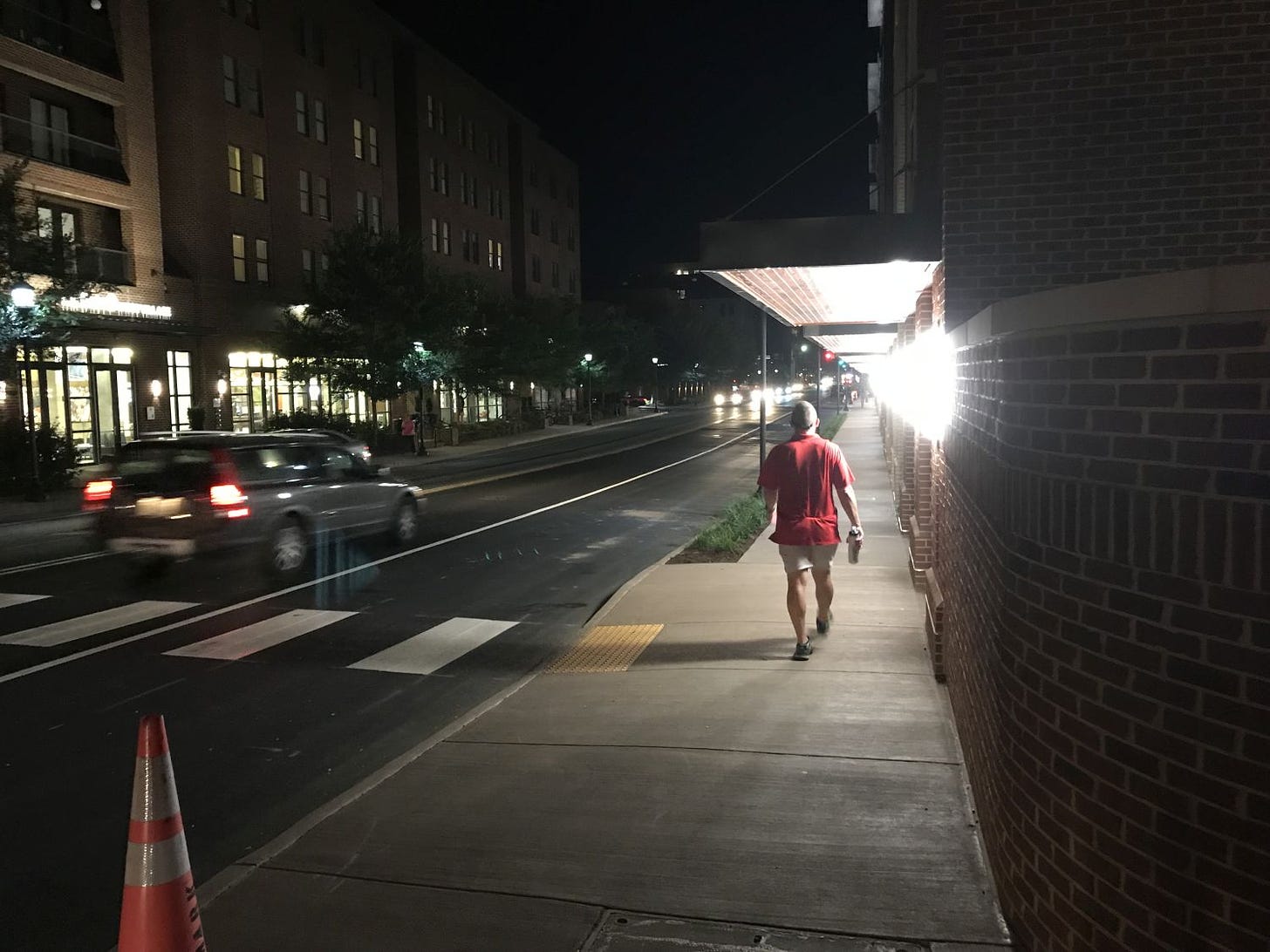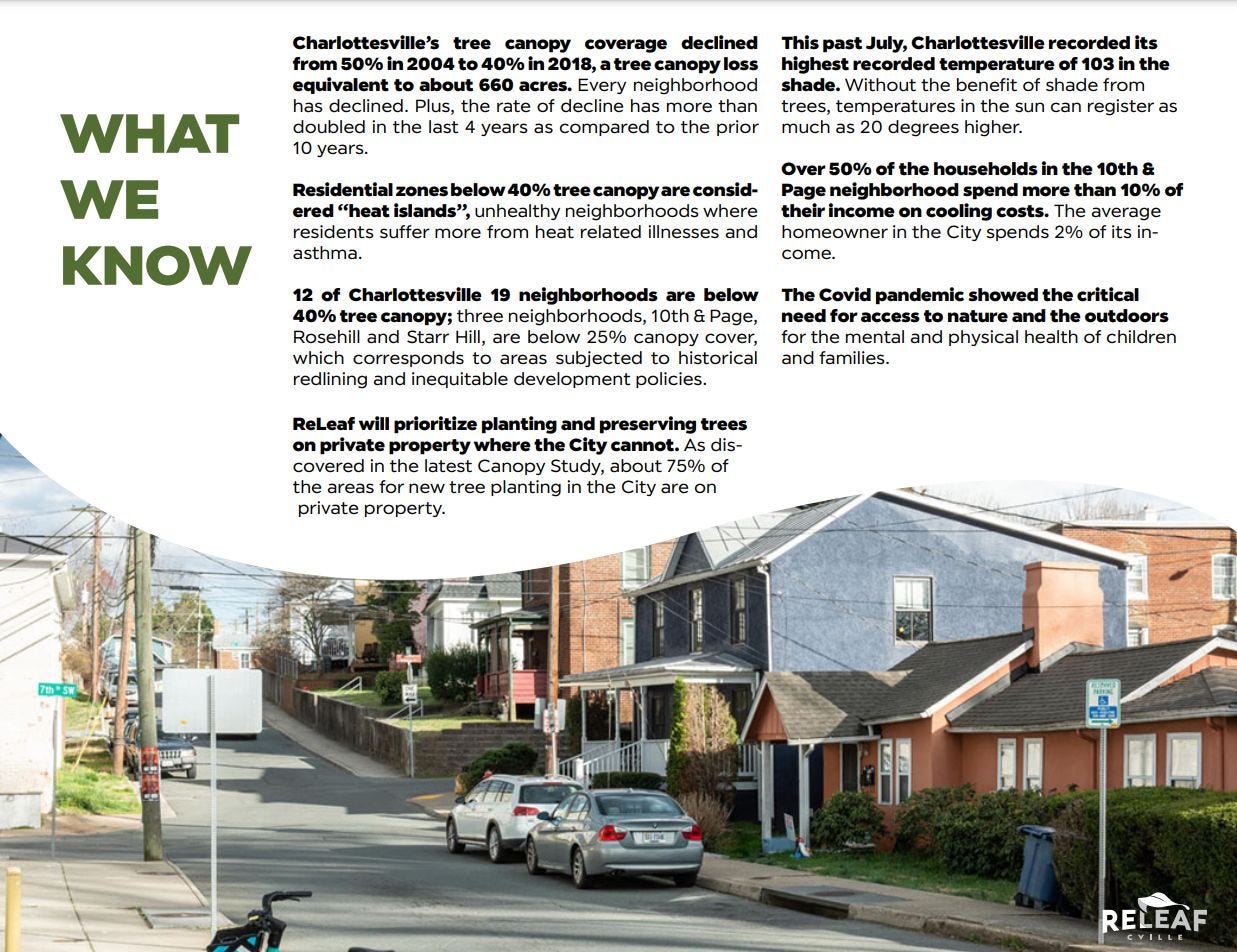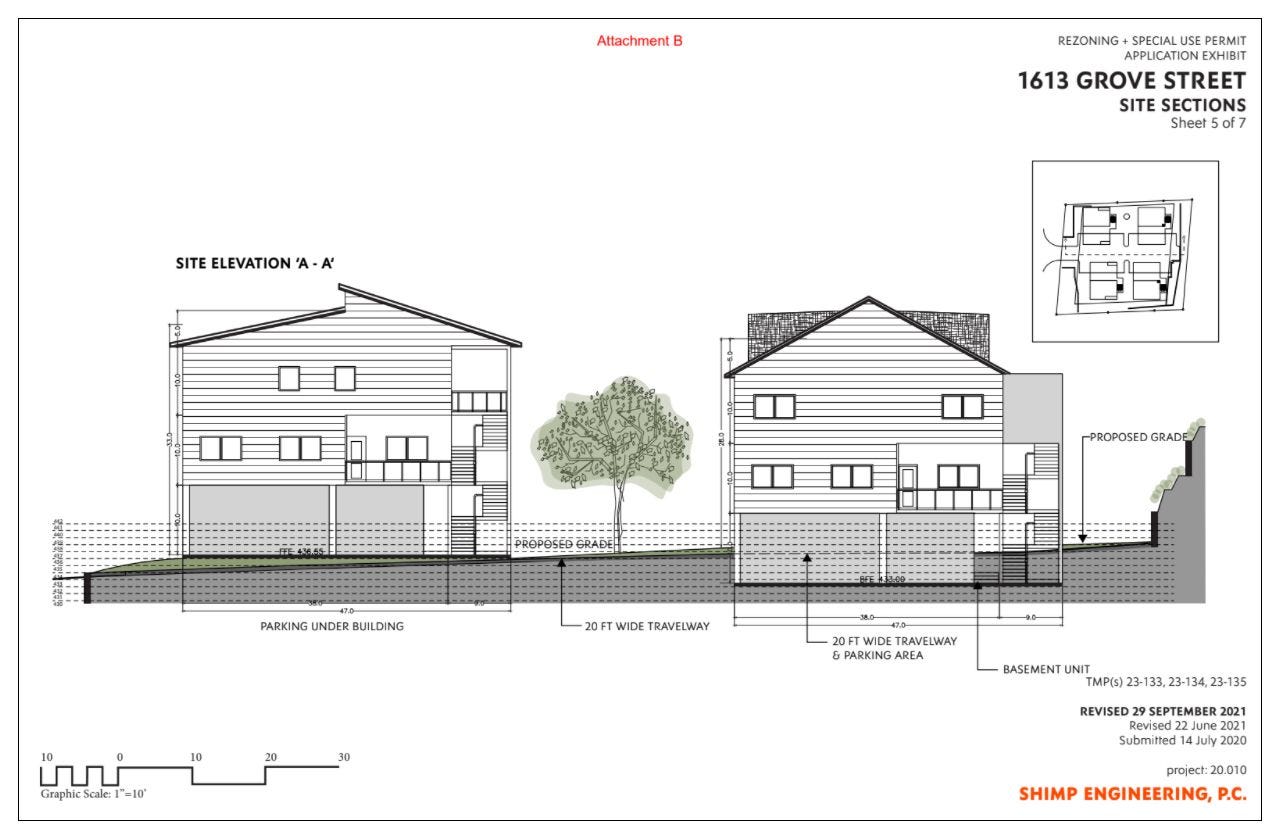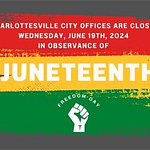This is the 78th day of the year, otherwise known as March 19, 2022. We are days away from the spring equinox, and there’s no turning back the clock in our future for some time. Sunlight and warmth fuel an explosion of vegetation, as well as the production of every installment of Charlottesville Community Engagement, a newsletter and podcast that seeks to keep you up to date on things trivial and things substantial. I’m your host, Sean Tubbs.
On today’s program:
A plan to build four seven-plexes on 0.62 acres in Fifeville gets the Planning Commission’s approval for a second time
A lawsuit seeking the voidance of the city’s new Comprehensive Plan moves forward
And the City Tree Commission presents ideas to the Planning Commission.
First shout-out goes for a Charlottesville United for Public Education event
Today’s first Patreon-fueled shout-out goes to Charlottesville United for Public Education who want listeners and readers to know about an event happening Sunday at 1 p.m. at the Ix Park in collaboration with the Black Parents Association. They’re looking for people who want to show support for local public schools and speakers will provide updates on school reconfiguration and the city’s budget cycle. There will be art activities, bubbles, poster making, Kona ice, and an appearance of the Free Book Bus. Visit charlottesvilleunited.org to learn more.
Charlottesville served with suit against the Comprehensive Plan
The city of Charlottesville has been formally served with a lawsuit that seeks to overturn the Comprehensive Plan adopted by City Council last year. Seven anonymous parties filed the suit in Charlottesville Circuit Court in mid-December arguing that the city did not follow state law when adopting the plan. (visit the code)
However, the city had not yet been formally served with the suit, which requires a response from the city. Interim Deputy Communications Director David Dillehunt confirmed receipt of the suit on Friday, meaning the city has until April 8 to make a response to the court.

The suit argues four points of failure, one of which is an alleged lack of “designation of new and expanded transportation facilities… that support the planned development of the territory covered by the plan.”
The anonymous property owners include people who own land on Rugby Road, Altavista Avenue, Davis Avenue, Locust Avenue, and Rugby Avenue. They claim the Future Land Use Map is too specific in nature and argues the additional density called for in the plan is affecting property values.
“For example, a house located at 507 10th Street NW, which is currently assessed at $315,000, is being marketed at $485,000 due to its development potential based on the higher density prescribed in the plan,” reads paragraph 16 of the suit.
There are actually two houses at that address, and both and the 0.19 acre property sold for $475,000 to Bloom Hill LLC, which has an address in Somerset, Virginia.
The transportation argument claims that rather than writing a new transportation plan, the plan adopted in November 2021 recycles previous plans such as the 2015 Bicycle and Pedestrian Master Plan and the 2016 Streets That Work Plan.
“Despite radically upzoning all of the real estate in the City, which will result in significant population increases, the Plan fails to include transportation infrastructure improvements to support the increased density,” reads paragraph 22.
The suit also alleges that the city failed to provide public notice that a vote would be held after the November 15, 2021 public hearing.
The Comprehensive Plan was the second achievement of the Cville Plans Together initiative, following on the heels of an affordable housing plan that Council adopted in March 2021.
While the lawsuit makes its way through the legal process, staff in both the city’s Neighborhood Development Services Department and consultant Rhodeside and Harwell are working on the zoning code. The next step in the process is release of an assessment of whether the approach they are taking will yield the desired results.

Tree and Planning Commissions discuss loss of Charlottesville trees
Virginia State Code assigns the task of overseeing the Comprehensive Plan to the Planning Commission. Earlier this month, members of the Tree Commission urged Planning Commissioners to consider the importance of woody perennial plants.
“Our tree canopy is declining at an increasing rate,” said Jeffrey Aten, the vice chair of the Tree Commission. “We have good intentions and are planning for a robust urban canopy in our Comprehensive Plan. But we believe more needs to be done to ensure this is the case as we build for more affordable housing and adjust streets to be more friendly for pedestrians and cyclists.”
The city is finalizing a tree canopy study that appears to indicate the total tree canopy is at 40 percent of Charlottesville’s 10.2 square miles, down from 47 percent in 2008. The most recent report is based on data from an aerial survey conducted in 2018.
Aten said that there are improvements that could be made to the city code to protect trees.
“We believe that there are code issues that we can work with the Planning Commission on revising and updating,” Aten said. “Development in the city has been happening per code and staff is enforcing code but we believe the code does need to change to help preserve some existing high value trees and to really incentivize developers to work with the city to keep those trees and or plant new ones when existing ones must be removed.”
Tree Commission Peggy Van Yahres said her group also wants to make sure there is better protection for trees during construction and greater costs to disturbing a public tree such as oaks on Garrett Street that were recently removed to make way for the redevelopment of Friendship Court.
“In Richmond, they have an ordinance when a developer is allowed to take down a public tree they have to pay into a fund for more planting around the city and this can result in hundreds of thousands of dollars,” Van Yahres said. “Those oaks would be conservatively estimated at $25,000 a piece so eight times 25 would be $200,000!”
Van Yahres said the Tree Commission wants the zoning ordinance to be updated to make sure trees are considered a vital asset. That means maintaining requirements that buildings be set back from the property line. The Standard on West Main Street is an example of a building constructed right to the sidewalk and public realm.
“Some people think that means you’re going to lost a lot of land,” Van Yahres said. “We’re not talking about huge set backs. Ten feet, fifteen feet.”
The Tree Commission also wants to be able to look at site plans for large projects like Friendship Court.

Commissioner Rory Stolzenberg said during the code review, he wants consideration of ways to plant more trees in the right of way of streets by reducing space for cars.
“And I wonder if we can look at our rules to make it make more sense to be able to fit trees in front of buildings even without increasing set backs by using that right of way,” Stolzenberg said.
Commissioner Jody Lahendro said the city could learn a lot from the University of Virginia regarding the treatment of trees.
“They’ve been treating their ash trees for many, many years now to save them,” Lahendro said. “They’re adding trees all the time. They have an arboretum committee that reviews any proposal to remove a tree. Has to be approved. They have two arborists on staff.”
Bill Palmer works in the Office of the UVA Architect and sits on the Planning Commission as a non-voting member. He acknowledged that there has been canopy loss associated with at least one major construction project at the Emmet-Ivy corridor.
“There was a landscape of trees there that is no longer there,” Palmer said. “We’ll be putting them back but trees take a long to grow. But the end result thirty years from now will be much better than what was there before and also meet UVA’s mission.”
If you want more on this topic, go watch the Tree Commission’s Codes and Practices Subcommittee on Charlottesville’s streaming media portal. (watch)

Second Shout-out goes to Mulch Madness!
In today’s second subscriber-supported shout-out, are you ready for Mulch Madness? The Rivanna Solid Waste Authority has a free mulch giveaway through April 16. In between all the big games, the RSWA wants you to get your yard ready for spring. If you have a way to transport mulch, head on over to the Ivy Material Utilization Center between 7:30am and 4:00pm, Monday through Saturday, where you can pick up up to two tons free. Rivanna staff are available to help load, but ask that you bring a covering. Mulch is double ground and derived from vegetative materials brought to Ivy for disposal. That’s Mulch Madness at the Ivy Material Utilization Center. Visit rivanna.org to learn more.
Divided Planning Commission recommends Grove Street rezoning
There was a slightly different vote this month when the Charlottesville Planning Commission once again recommended approval of a rezoning that would allow 28 units to be built on just under two thirds of an acre on a cul-de-sac in the Fry’s Spring neighborhood.
In October, the Charlottesville Planning Commission voted 4-2 for the rezoning, a vote at which Commissioner Taneia Dowell was not present. However, Dowell joined Commissioners Hosea Mitchell and Liz Russell in voting against the proposal, which also required a special use permit for additional density and a critical slopes waiver.
The public hearing for all three had to be held a second time, as city planner Matt Alfele explained at the March 9 Planning Commission meeting.
“In preparing to move the application forward to City Council it was discovered one of the tax map parcel numbers was mistyped in the public ad,” Alfele said. “To ensure accuracy, all three applications have been readvertised and returned to the Planning Commission for action. No information has been changed or been updated in the application materials.”
As was the case in October, the developer will contribute $48,000 to construct pedestrian improvements in the Fifeville neighborhood and 28 percent of the units will have some affordability provision for at least ten years. Civil Engineer Justin Shimp is working on behalf of property owner Lorven Investments.
“Twenty-eight percent in total affordable, which is eight units,” Shimp said. “Of those, four of the them, the rent including the utilities is capped at the [U.S. Department of Health] fair market rate.” (learn more from HUD about fair market rent)
The other four would be called at 125 percent of the fair market rate, which is the upper limit for a unit to be eligible to receive housing vouchers.
The Comprehensive Plan designation has changed since the October 2021 review.
“The Comprehensive land use map for this area calls for General Residential which recommends up to 2.5 stories in height, up to three units per lot, or four units if an existing structure remains,” Alfele said.
This application would have four seven-unit buildings with some three-story and some four-story buildings for what Shimp called a sevenplex that provides bonus density in exchange for providing housing at a below-market price. That’s a basic tenet of the Affordable Housing Plan Council adopted in March 2021.
“We ended up with buildings that are basically three stories in the front and then kind of three stories but with units in the attic that backfill and have units in the roof system,” said civil engineer Justin Shimp. “So, trying to keep it at that 30 to 35 unit building height.”
Alfele had recommended denial of the rezoning in part because of the conditions on Valley Road Extended.
“Valley Road Extended on the east side you have Rock Creek and on the western side you have a fully developed neighborhood with limited sidewalks and with parking,” Alfele said. “Any improvements to Valley Road for pedestrians and foot traffic would be a major undertaking and would remove parking from existing homeowners.”
Only one community member spoke during the public hearing. Paul Benneche was concerned about the potential for Valley Street Road to handle additional vehicles.
“By my count, I counted the houses on that road currently and this would seem to increase the total number of people on that road by 30 to 40 percent potentially,” Benneche said. “It just seems like that road is already not wide enough. It’s only about one and a half lanes wide.”
Vice Mayor Juandiego Wade was not on Council when the matter was last before a joint meeting. In the late 2000’s, Wade worked for Albemarle County as a transportation planner.
“I’m trying to figure out from my planning days, even back then, $48,000 doesn’t get you much sidewalk,” Wade said, “Or is there a new way to build them cheaper now? What are we getting for $48,000? Why not $40,000 or $50,000? What’s magic about $48,000? Is it a formula or something?”
Shimp said $48,000 did come from the formula that the city uses to calculate what a developer would pay if they got a waiver from having to build a sidewalk in front of their development. In this case, they are also building a sidewalk in front of the new units.
“The site plan ordinance requires us to build our own sidewalks and then we would offer the money up for some improvement down the road,” Shimp said. “We talked last time about maybe something at the entrance of Valley Road Extended. That would be up to the city. We tried to make the proffer sufficiently vague so it could be used where in that neighborhood it made sense.”
Commissioner Rory Stolzenberg said he supported the plan because it is an example of what should be built under the General Residential designation across the city.
“There’s no buildings to demolish on this site so that’s a fourplex by right, and then we have provisions for bonuses at affordable housing,” Stolzeberg said.
Stolzenberg said there are other thin roads that lead to cul-de-sacs such as Altamont Street in North Downtown.
“People kind of manage and people walk in the street and then people slow down when they see them,” Stolzenberg said.
Commissioner Liz Russell had a different interpretation of General Residential.
“My take on the General Residential category is three units per lot with an additional bonus and we haven’t defined what that bonus is, but presumably it would be another unit,” Russell said. “So we have three parcels here and the max would be four units per parcel, twelve units max. And this is a proposal that proposes no more than 28.”
After some discussion, the vote was taken again and resulted in a 4 to 3 vote on both the rezoning and the special use permit, but Commissioner Hosea Mitchell did vote for the critical slopes waiver.
The matter will next go to before City Council at a later date.
The original plan pointed to a concept in the city’s 2016 Bike and Pedestrian Master Plan which showed a tunnel underneath the railroad track to what is now the University of Virginia’s Brandon Avenue precinct. The end of Valley Road Extended is only 250 feet away from an access road behind Bond House, one of UVA’s newest residence halls. Valley Circle is a few more steps away.
However, there are no actual plans for such an underpass.
Support the program!
Special announcement of a continuing promo with Ting! Are you interested in fast internet? Visit this site and enter your address to see if you can get service through Ting. If you decide to proceed to make the switch, you’ll get:
Free installation
Second month of Ting service for free
A $75 gift card to the Downtown Mall
Additionally, Ting will match your Substack subscription to support Town Crier Productions, the company that produces this newsletter and other community offerings. So, your $5 a month subscription yields $5 for TCP. Your $50 a year subscription yields $50 for TCP! The same goes for a $200 a year subscription! All goes to cover the costs of getting this newsletter out as often as possible. Learn more here!


















March 19, 2022: Suit against Charlottesville Comprehensive Plan moves forward; Planning Commission votes 4-3 to recommend Grove Street rezoning for 28 units